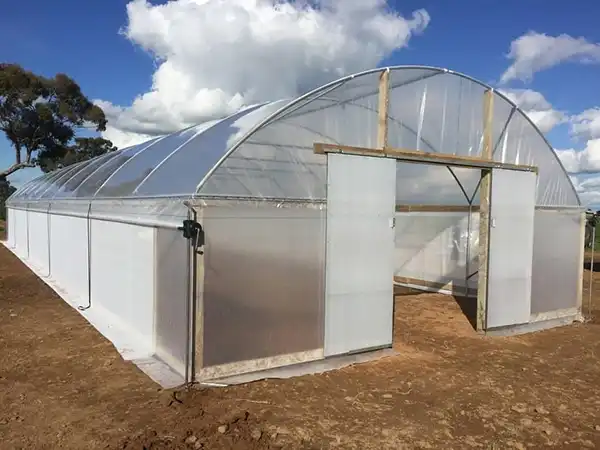Maximising Sunlight in Your Greenhouse: The Role of Effective Glazing
Key Takeaways
- With the right glazing, the greenhouse effect can be amplified and also contribute to the nourishment of greenhouse plants.
- Glazing materials such as glass, polycarbonate, acrylic, and polyethylene films play a significant role in regulating sunlight for plant growth.
- To optimize sunlight absorption, strategies such as proper orientation, shade cloths, reflective surfaces, and regular cleaning of the glazing material are vital.
- The choice of glazing material is pertinent for creating an ideal microclimate for plants in a greenhouse.
The journey of every horticulturist involves a continuous quest for ideal growth conditions. At the core of this pursuit lies the concept of harnessing sunlight, which is vital for photosynthesis and, by extension, plant health.
In greenhouses, where controlled environments reign supreme, the role of effective glazing becomes paramount.
Let’s illuminate how the right glazing can amplify sun ray absorption and contribute to the flourishing of your glasshouse plants.
The Symphony of Sunlight and Glazing
A greenhouse’s primary function is to create a microclimate, providing warmth and sunlight irrespective of the weather conditions outside.
This is achieved by trapping the sun’s radiant energy, thus warming the interior. Glazing plays a pivotal role in this process, determining how much light is absorbed, diffused, or reflected.
Do You Know?
According to a survey, there are approximately nine million acres of greenhouse globally.
Glass: The Classic Conductor
Benefits:
When we think of glasshouses, the image of clear glass structures often comes to mind. It is an excellent transmitter of sunlight, allowing almost all available light to penetrate.
This high clarity ensures that plants receive a natural spectrum of light, closely mimicking outdoor conditions. Normally glass transmits visible light at a rate of 90%.
Drawbacks:
While glass excels in clarity, it can sometimes be too effective. On particularly sunny days, there’s a risk of overheating or causing sunburn to flora due to the intense, direct light.
It also tends to be fragile and can be a more expensive option. There are probabilities of glass shattering due to bad weather and one is bound to replace it every year.
Polycarbonate and Acrylic: The Modern Maestros
Benefits:
Polycarbonate and acrylic panels represent modern advancements in greenhouse glazing. They are both lighter than glass and offer impressive durability, making them resistant to impacts like hail.
Their greatest strength, however, lies in their ability to diffuse light. This means sunlight is spread more evenly throughout the conservatory, reducing the risk of sunburn and ensuring all plants get their share of the sun. Polycarbonate is also 250 times stronger while acrylic is ten times stronger than glass.
Acrylic lets more light than glass at a 92% rate. On the other hand, Polycarbonate comes third at a rate of 88%, but it does have the benefit of UV resistance.
For those considering acrylic options, companies like Simply Plastics offer a range that can be tailored to its needs, balancing light transmission and diffusion effectively.
Drawbacks:
Though they offer diffusion, these materials can sometimes scatter sunshine too much, potentially depriving herbs of adequate direct sun rays. Over time, both polycarbonate and acrylic can degrade or become discoloured, impacting their effectiveness.
Polyethene Films: The Budget Maestro

Benefits:
For gardeners on a budget, polyethene films present a cost-effective glazing solution. They allow a good amount of sunshine to pass through while offering some diffusion. UV-resistant varieties ensure longer life spans and better sunbeam transmission.
Drawbacks:
The insulative qualities of polyethene are inferior compared to rigid materials. Moreover, being softer, they are more prone to tears and may need replacement more frequently.
Enhancing Sunlight Absorption
While choosing the right material is fundamental, there are complementary strategies to maximize light in your greenhouse:
- Orientation: Positioning your glasshouse with its longest side facing south (in the Northern Hemisphere) ensures maximum sun ray exposure throughout the day.
- Shade Solutions: During peak summer, consider using shade cloths. They can be deployed to reduce excess sun rays and prevent overheating or scorching.
- Reflective Surfaces: Placing reflective materials or white fabrics on the ground can bounce sunshine back into the greenhouse, ensuring even the lower parts of plants receive light.
- Regular Cleaning: A simple yet often overlooked step. Ensuring your glazing material is clean helps maintain optimal light transmission. Dust and grime can significantly reduce the amount of sunlight entering the house.
Conclusion
The relationship between sunlight and glazing in a greenhouse is symbiotic. While sunshine provides the energy herbs need, effective glazing ensures this energy is utilized optimally.
No matter whether you gravitate towards traditional glass or modern acrylic panels from trusted suppliers like Simply Plastics, understanding the nuances of each material will aid in creating a radiant haven for your vegetation.
In this dance of light and growth, may your plants always find their spotlight.
Follow Us
Latest Post
















